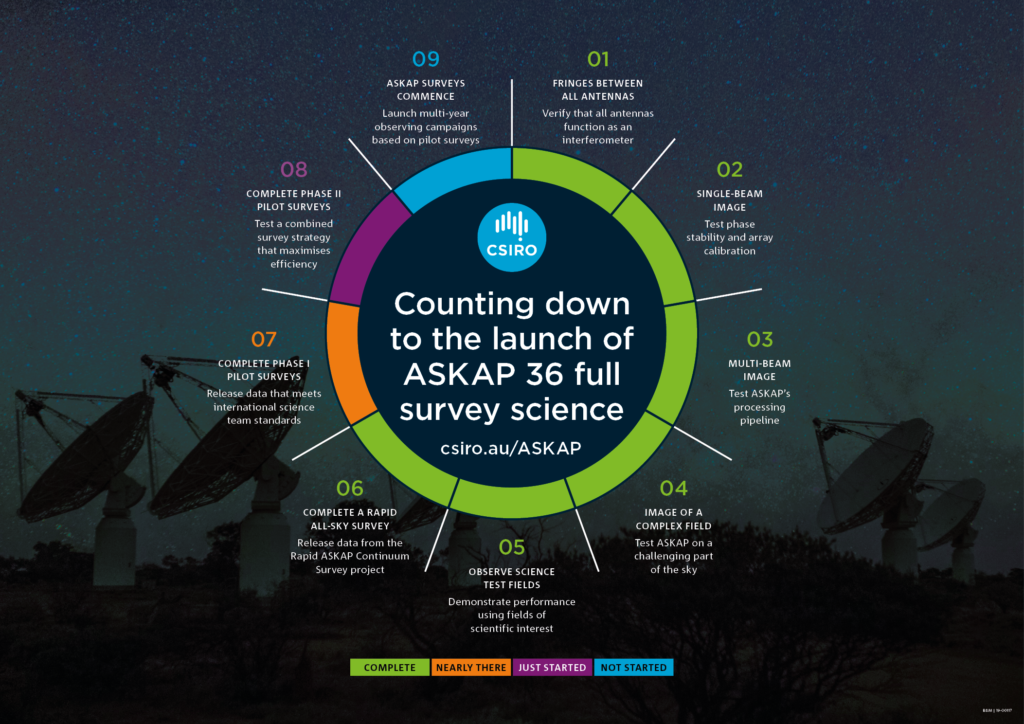
Two ‘bent-tail galaxies’ appear as if to be two dancing ghosts. The swirling, translucent shapes are the radio signatures observed by ASKAP, overlayed on an optical image from the Dark Energy Survey.
Our new ASKAP telescope is getting closer to launching into full science mode. Before then it is entering one more test phase.
Nine survey science teams, with wonderful names like POSSUM, DINGO and FLASH, have spent the past year exploring the cosmos while checking the telescope’s capabilities. Some 739 astronomers from 208 institutions all over the world make up these teams. In this next phase, they will be deepening their observations.
ASKAP is different to other telescopes. It can survey large parts of the sky at a time, while still capturing incredible detail. No other telescope in the world can do this to the same degree. This is due to the unique receivers on each dish that intercept radio waves from space. So much data is produced from each sky survey that much of it from the first phase of ‘pilot’ surveys are still being released.
So far the test data, processed at the Pawsey Supercomputing Research Centre, has been incredibly informative. The ASKAP survey teams uncovered fast radio bursts, odd radio circles and one million new galaxies in Phase I. These never before seen discoveries and many mysterious objects challenge our understanding of the Universe.

The Phase II pilot surveys are the last step before ASKAP launches full science mode.
Going through a phase
The VAST survey team plan to build on their earlier scientific analysis. Having demonstrated ASKAP’s capabilities in detecting objects like pulsars and galactic nuclei, they will use the next phase to become more efficient in crunching the data. Speed can be important, as other telescopes need to be notified to look at the same patch of sky when ASKAP detects curious or exciting phenomena. Sometimes, like ‘seeing’ massive flares from nearby stars, we only have minutes to swing other telescopes into action.
The largest radio survey ever completed to these sensitivities is EMU’s Phase I pilot survey. Their Phase II survey will extend that record further. EMU has already discovered intriguing radio signatures, including the image of two ‘dancing ghosts’. Among the flowing shapes are two radio galaxies that are also types of bent-tail galaxies. These weird shapes are challenging our understanding of radio galaxies.
Another survey science team, WALLABY, will be scanning large regions of the sky known to contain many galaxies full of hydrogen gas. However, some regions have been specially selected because they are difficult to analyse. Bright sources, such as a large quasar known as ‘3C 279’ (very catchy!), are useful in other surveys but get in the way of WALLABY ability to detect fainter sources. In Phase II, the team will explore how best to separate the gas-rich galaxies in their data from the rest.
By uncovering challenges like this in the Phase I pilot surveys, Phase II gives us the chance to overcome them. Like any new tool, it takes time to know how to wield it well! But that doesn’t stop you from learning great things along the way. With ASKAP’s 36 antennas already capturing so much information from space, there will be plenty of exciting news to share throughout Phase II of the pilot surveys.
And by figuring out what ASKAP does best, scientists will be able to plan and advise on the next generation of research.
We acknowledge the Wajarri Yamaji as the traditional owners of the Murchison Radio-astronomy Observatory site.

